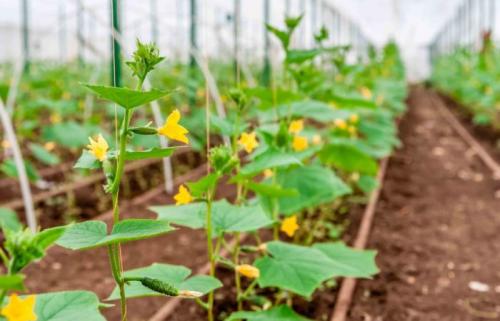How to determine the acid content in soil at home - ways
Before starting to take measures to reduce the acidity of the soil, it is necessary to accurately establish its amount, that is, to measure the pH. To begin with, they inspect the garden and surrounding areas for the presence of such plants as:
plantain;
moss;
wheatgrass;
wood lice;
Ivan da Marya;
horsetail.
If these grow in large numbers, therefore, the soil is highly acidic and cultivated plants will be uncomfortable. In addition, at such a pH, a wireworm and a nematode settle in the soil, and the click beetle, a pest of garden plants, actively reproduces.

The most effective and accurate way is to take soil samples from different parts of the garden to the laboratory. You can do it yourself, using folk methods, but the results will be approximate. In this case, you can go too far with deoxidizers, or vice versa - add a little.
How to check the soil:
Take 10 young leaves of black currant, place a liter jar in the floor and pour boiling water over it. Wait until it cools completely, then toss in a couple of tablespoons of soil. If the water turns red - the soil is acidic, it turns blue - slightly acidic, green - the soil is neutral.
Take a handful of earth and pour a teaspoon of vinegar over it. If it starts to sizzle, then the soil does not need deoxidation - there are enough carbonates in it. If the hiss is not heard, alkalinization measures will have to be carried out. With this method, there is no exact indicator, therefore this test is carried out in the event that some crops grow poorly or do not yield a crop.
Litmus paper helps to roughly determine the degree of acidity, but also does not give an exact figure. To do this, mix the same amount of distilled water and earth, dissolve, infuse for 15 minutes, then filter and dip litmus paper there. After 3 minutes, you can check the test scale.
There are instrumental, more accurate methods, for example, using a pH meter.
pH meter
There are high-precision instruments made in Japan. If the soil on the site often changes acidity, then it makes sense to purchase such a device and use it to control the composition of the soil. To check, you need to do the following:
Mix 20 g of soil with 20 ml of purified water.
Stir and leave for 1 hour.
Filter the liquid into another container.
Measure indicators.
After working with the device, it must be thoroughly rinsed with clean warm water and calibrated with distilled liquid.

How to improve?
Do not be upset if the soil on the site is alkaline. To lye it, experts assure, it will turn out faster than deoxidizing it. And, if you correctly carry out the appropriate measures in the fall, then spring will bring the first results.

But it must be borne in mind that the fight against lime in the soil will have to be carried out constantly, a single action will not give a long-term effect.
- For slightly alkaline soil, horse peat is well suited. It will not only acidify the earth, but also significantly improve its structure. It will react faster and better to the fertilizers applied, it will be better to let air through, that is, it will become looser. Peat is added in an amount of 1.5 to 3 kg per 1 m2.
- If for some reason a person uses only organic fertilizers, then manure, both fresh and rotted, will help to lye the earth. The first one is much more active, therefore it is brought in less than rotted, about 3 times. Manure can be applied only before digging the earth. Fresh manure is needed up to 3 kg per 1 m2, rotted manure - up to 9 kg for the same area.
- Not only to make the soil neutral, but you can also mulch it with the help of rotted needles. Not only needles are suitable, but also coniferous sawdust. For 1 m2, you need to make from 3 to 5 kg.
- Early spring is the time to apply mineral fertilizers (urea, ammonium sulfate and nitrate). They are introduced only before digging in strict accordance with the instructions for use. They also neutralize the action of alkali in the earth.
- Some plants improve the quality of the soil by their mere presence. They are called siderates. These are annual plants, the purpose of planting is to enrich the soil with nitrogen, loosen it and acidify it, as well as saturation with moisture and air in all its layers. Siderates include, for example, clover, peas, beans, lentils, oats, oil radish. Legumes are an irreplaceable thing for soil acidification, three harvests of any of these crops are equal in efficiency to the effect of fresh manure on alkaline soil. Planting green manure is an excellent method for improving soil fertility.
- You can reduce the pH of alkaline soil by resorting to reclamation measures. There is also a known method of fertilizing soils with calcium sulfate, known to everyone as gypsum (naturally, dry, in powder form). As soon as gypsum is introduced into the soil, the absorbed sodium is replaced with calcium. The saline horizon is improving, the throughput of the soil increases, moisture begins to flow into the deep layers, and, consequently, there are fewer and fewer excess salts. However, it will take some time to fix the condition of the earth.
- Experienced gardeners have also appreciated the oxidation of soils with granular sulfur. It is applied according to the schedule - no more than once every three months and in limited quantities - approximately 20 kg per hectare. It is not worth waiting for an instant effect from such oxidation, the first results will be visible no earlier than after a year from the moment of the first application.
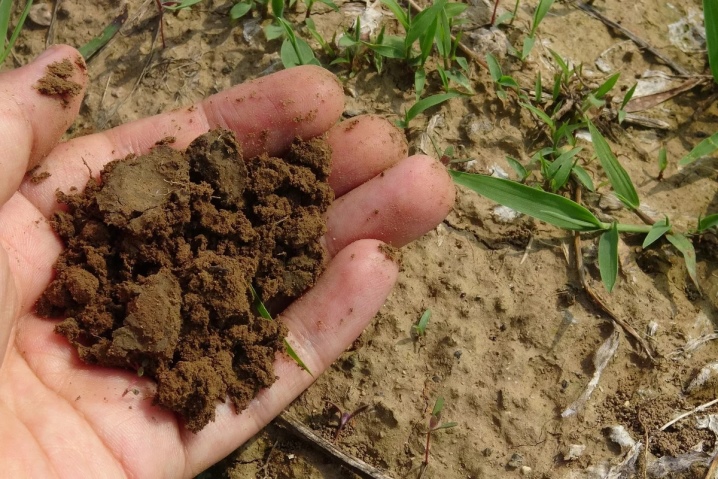
Useful Tips
Next, we will consider the nuances of caring for clematis so that it grows, blooms and delights you with its beauty. By the way, with proper handling, this vine can live for about 25 years.
- First of all, even before you go to the store to buy clematis, decide where he will "live". The fact is that he does not like to be transplanted often.
- You have chosen a place and it is time to purchase a seedling. Be careful: when buying a plant that has barely reached 10 centimeters in height, you may face its unviability. Even if such a clematis survives, it will be frail and more demanding to care for than usual. Therefore, it is recommended to choose a sprout about 20 centimeters in height and with well-developed closed yellowish roots in the amount of 5-6 pieces. You should see 2-3 shoots with developed leaves and buds. This appearance of clematis corresponds to two or three years of age.
- You can plant a plant both with the arrival of autumn and in spring. Spring planting is preferable: the vine will grow up, strengthen over the summer and will be able to endure the winter cold.
- The location of the vine should be sufficiently isolated, protected from the wind. Young shoots will first have to be covered with non-woven material, shaded. For the winter, clematis must be covered so that it does not freeze.
- Sometimes it happens that an amateur gardener, not waiting for the violent growth of a recently planted plant, decides that, most likely, an unsuitable place for planting was chosen and transplants the vine. However, there is no need to rush: the fact is that in the first couple of years clematis "throw" all their strength into growing and strengthening the roots, so the superficial greenery seems scarce.
- Young sprouts require special care in the first years of life. Pull the weeds around them, but be careful not to damage the delicate rhizome of clematis. Attach the stem to the support. If a strong wind has risen, it is raining, or, conversely, it has not been there for a long time, and the sun is "hot", cover the seedlings with a light non-woven cloth.And even more preferable would be a mini-greenhouse made from a 5-liter plastic bottle with a cut-off bottom, the lid of which you can open and close when required.
- Pruning clematis in the first couple of years of life is prohibited, since the plant must grow and get stronger. This is especially true for plants planted in the ground in late summer and early autumn. In general, all that is required of you during this period is to water, feed and process the vine from pests.
- Earlier we mentioned that in order to avoid flooding with groundwater, it is necessary to fill the drainage mass into the clematis hole. It can be formed from crushed stone, broken brick and coarse sand. The drainage layer should be at least 15 centimeters thick.
- In the springtime, in order to feed your clematis and increase its resistance to diseases, you can pour it with the following mixture: dilute 1 glass of dolomite flour or crushed chalk in 5 liters of clean water, add a tablespoon of the preparation containing copper.
- Feeding with ash very well affects clematis - they begin to bloom better, the roots stop rotting, and harmful insects bypass the plant.
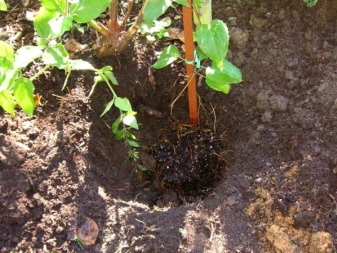
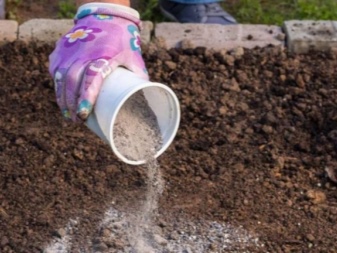
How to properly plant clematis, see below.
How and how to deacidify the soil in summer
Soil acidity was determined. Now you need to decide what to do to change it. In the summer, you can deacidify the soil with the help of mineral and organic substances. Planting some siderates will also be effective. Each method has its own adherents.
In order not to harm the plantings, in the summer, substances such as dolomite flour and gypsum are used as deoxidizers. Dolomite flour is suitable for light and clay soils. Thanks to her, the first are enriched with magnesium, which they always lack. In the latter, the composition and structure of the soil are improved. You can also recall other useful properties of dolomite flour.
9 health benefits of dolomite flour you never knew existed
Learn how to use dolomite flour effectively on your site.
Dolomite flour does not burn the roots and leaves of plants, so it can be used all year round. It is scattered over the surface or mixed with earth. The application rates depend on the level of soil acidity and range from 350 to 600 g per 1 sq. M.
On acidic soils, 500-600 g per 1 square meter is applied, on soils of medium acidity - 450-500 g per 1 square meter, and on slightly acidic soils - 350-450 g per 1 square meter.
To maintain the neutral composition of the soil, it is recommended to periodically introduce 100-150 g of dolomite flour per 1 sq. M.
Good for soil deoxidation and gypsum
It has one important advantage: it needs acid to dissolve in earth, not water. By neutralizing the soil, the mineral substance ceases to act
As soon as the acid level in the soil rises, the gypsum reacts again.
On weakly acidic soils it will be enough to add 100-200 g per 1 sq. M, on medium acid soils - 300 g per 1 sq. M, on acidic - 400 g per 1 sq. M.
How to deacidify soil with ash
Ash and eggshells are natural deoxidizers. But they are less effective than mineral ones. And you need to make much more of them, which makes it difficult to collect the required amount. So, wood ash for normal soil deoxidation requires 1-1.5 kg per 1 sq. M, and ash from burnt grasses and weeds, in which there is less calcium, is already 2.5 kg per 1 sq. M.
The ash contains trace elements, but the introduction of a large amount of it into the soil can lead to an excess of them. Therefore, it is better to use this substance on slightly acidic soils, where it is needed less.
How to deacidify soil with eggshells
To deoxidize the soil, it is better to use eggshell flour, rather than pieces of it. It is not difficult to prepare it. The dried shells are crushed with a rolling pin or pestle in a mortar, then ground in a coffee grinder or food processor.
Eggshell flour should be applied 500 g per 1 sq. M. Its efficiency is even lower than that of ash.She can reanimate acidified soil only at the initial stage. Calcium from the shell passes into the ground for a long time and slowly. So the plants are of little use.
Weakly acidic soils should be deoxidized once every 5-8 years, acidic soil - once every 3-4 years.
Growing green manure for soil deacidification
Some green manure plants not only fertilize the soil well, but can also deoxidize it. Phacelia, white mustard, sweet clover and alfalfa are better suited for these purposes. With proper crop rotation, you can even do without the use of minerals altogether.
Phacelia, regardless of its predecessors, is sown from March to August (the norm is 10 g of seeds per 1 square meter), mowed down in a month. But white mustard is not sown after all types of cabbage, radish, turnip and radish. After other crops, it can be sown at any time (the norm is 2 g of seeds per 1 square meter), and mowed - 40 days after the first shoots.
Beans, peas, soybeans, chickpeas, and lentils are prohibited precursors for alfalfa and sweet clover. The first is planted from mid-April to mid-May, from mid-July to mid-August (the norm is 15 g of seeds per 1 square meter) and mowed after 1.5 months. Donnik - from March to August (the norm is 2 g of seeds per 1 square meter), and mowed after 3 months or the next year.
When and how to sow green manure correctly - all information in one article
What do some weeds, cereals, fodder and ornamental crops have in common? All of them can be excellent fertilizers when used correctly!
When deoxidizing the soil, it should be borne in mind that not all plants are harmful to acidic soil. Rhododendrons, blueberries, hydrangeas, conifers, heathers, etc. grow well on it. And all the main nutrients most vegetables and horticultural crops are obtained from slightly acidic soil.
When to plant clematis
Clematis seedlings can be planted both in spring and autumn.
For spring planting:
clematis should be planted under the open sky around TV in early May, when there is no longer a threat of frost - for young tender shoots, even a slight drop in temperature can be disastrous
If you purchased seedlings too early, they will feel great in your home;
however, there is a risk of being late - when you plant clematis, its buds should not yet grow, otherwise there is a possibility that it will not take root;
when planting in spring, it is very important to choose the right time, because otherwise you risk losing your plant. It should not be planted either too early or too late, so be guided by the weather in your area.
For autumn planting:
- it is best to plant clematis, starting at the end of August, so that they have time to take root and build up a little mass before wintering;
- it is not recommended to plant clematis later than the beginning of October, even if you live in regions with a rather warm climate;
- be sure to insulate clematis immediately after planting, and make a high-quality shelter for the winter - peat, dry foliage, lutrasil. Clematis must survive the winter well, otherwise next spring it may not move away from frost and cold weather;
- you can trim the clematis lashes very slightly before insulating it for the winter. Just don't overdo it.
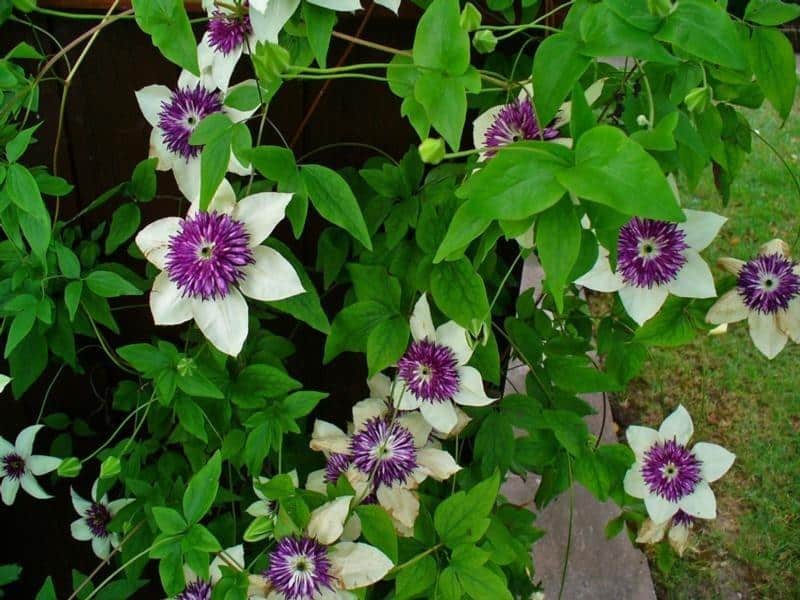
How to choose the right soil for planting clematis
The optimal solution to the problem of planting clematis will be to place it not in open ground, but in a container - a container or a large pot. Thus, during the year, depending on weather conditions, it will be possible to take the plant outside, or leave it indoors.
The convenience of this method of growing clematis has a number of nuances that must be taken into account. So, the container for growing clematis should be quite voluminous - at least 20 liters
You should also take care of the vertical support for clematis, since it belongs to vines and can rise up to a height of 2 m. Clematis grown in a pot will need regular feeding and frequent watering.In addition, it will have to be replanted every 3 or 4 years.
Regardless of whether clematis is grown in a pot or in a garden on the ground, you need to take care of a suitable soil composition for it. This vine makes quite a lot of demands on the landing site.
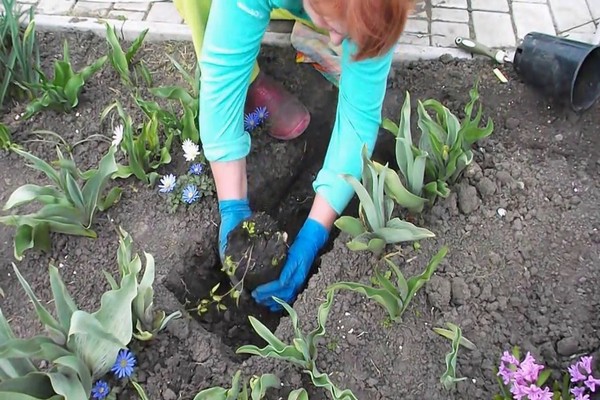
The most important ones are listed below:
1) Clematis prefer alkaline or neutral loamy soils. The soil should be loose, breathable, and sufficiently nutritious.
2) Advance preparation for planting clematis will be required, which should be started at least a year before the planned procedure
It is important that during this period the land in the area allocated for the vines had time to settle, and the substances introduced into it were evenly distributed, making the soil neutral.
3) Supports for vines are also installed ahead of time. The height of the supporting structures should be around 200-250 cm
Choose a strong material so that the supports can withstand strong winds, otherwise they may fall and damage the plants clinging to them. Supporting building walls or fences seems like a good idea to save budget and space. However, this is not recommended as the land near massive structures is usually too dry and barren. Clematis planted on it will not take root well and may die. In order to create the effect of a green cover over the walls of the house, you should place clematis supports at a short distance from them - 30 cm is enough. In this case, the rainwater flowing from the walls will not flood the clematis plantings.
4) In the summer, there is a danger of overheating of the root system of clematis, which is grown in the open field. This will be avoided by mulching the surface of the earth on a site with vines, which is recommended after planting, as well as in combination with plant care procedures. It does not hurt to create a slight shade for the roots of clematis by planting other plants. Marigolds would be an ideal choice - these flowers not only create shading and look beautiful, but also protect their neighbors from being hit by such a pest as a nematode.
5) The relief of the site can also significantly affect the development of clematis. It is best to give preference to flat surfaces. If the site is located on a hill, the growing season of clematis can be significantly reduced. Lowlands are also undesirable for flowering vines, since they are characterized by the accumulation of cold air. As a result, thermophilic clematis can freeze, which will adversely affect their growth and development.
How to acidify the soil in a garden plot
How to determine by the growing weeds whether the soil is acidic or alkaline on the site. About the methods of soil acidification
Most crops prefer neutral soil acidity, but there are some plants that do better on acidified soil. In gardening stores, you can buy a special device that measures acidity, temperature and humidity, but it is not cheap. Often the expediency of buying does not justify itself. In the absence of a device, it is possible to judge what kind of soil is in the possession by the growing weeds.
What plants grow in alkaline soil:
1. Field bindweed.
2. Quinoa.
3. Derain is white.
4. Cloves.
5. Euonymus.
What vegetation appears on acidic soil:
1. Horse sorrel.
2. Mariannik oak.
3. Clover.
4. Field horsetail.
5. Ledum.
If any of the listed plants are common, then you can understand whether the soil is acidic or alkaline in the garden. If these plants are found in single copies, then this is not an indicator.
How to acidify the soil on the site
1. Apply fresh manure in late autumn or early spring. As the manure decays, the soil will acidify.
2. Spill the soil with electrolyte mixed with water.You can take electrolyte from a car battery. 10 ml of electrolyte is sufficient for 10 liters of water. This solution is enough for about 15 sq.m. vegetable garden.
3. Use oats or rapeseed as green manure. These crops not only improve the structure of the soil, but also feed with useful substances, make it looser, and also acidify. You can sow green manures in a garden both in spring and autumn. Before the siderates begin to produce seeds, they are mowed and buried in the ground.
4. Add ferrous sulfate by dissolving 0.5 kg of powder in 20 liters of water, and then pouring 10 sq.m. vegetable garden. If the earth is not heavy, then it is better to add it without mixing it with water, otherwise it will quickly go into the lower layers of the soil.
5. Fertilize the ground with bog peat during the autumn digging, taking 1 sq.m. 1 kg of peat.
6. In autumn, add colloidal sulfur, scattering it over the top, and then covering it with a rake. Mixing with water during rain, sulfur will gradually increase acidity. For 1 sq.m. vegetable garden requires about 100 g of powder. The smaller it is, the faster the reaction will go.
7. Spill the beds with water and food vinegar. To do this, 100 ml of vinegar is diluted in 8 liters of water. The resulting mixture is applied to an area of 5 sq. M.
8. Add aluminum sulfate a couple of weeks before sowing the beds. To do this, the purchased powder is distributed over the site at the rate of 1 kg per 20 m2 of area. Close up shallowly into the soil.
When acidifying the earth, it is important not to overdo it, as then many cultures will simply perish. High acidity does not allow vegetation to absorb phosphorus, potassium, calcium and other elements necessary for normal development
All about the acidity of the soil mixture
The pH level is important for the normal growth of crops. There is no common value for all plants, but it is known that acidic lands are preferred by weeds and mosses. Viruses and other pathogenic microorganisms reproduce well here. Cultivated varieties "love" neutral or slightly acidic lands
Therefore, it is important to regularly research your garden and garden.
It often turns out that the pH level in the territory is different. This is normal, you just need to take the information into account when planning your landings. Deoxidation work can be carried out selectively. In the remaining places, place plants that grow well on moderately acidified soil.
List of crops for soil mixtures with moderate acidity
- Vegetables: carrots, turnips, potatoes, sorrel, tomatoes, radish, pumpkin.
- Berries: strawberries, cranberries, lingonberries, blueberries.
- Decorative: azaleas, hydrangeas, conifers, chicory, all types of ferns.
For all types of fruit trees and shrubs, such conditions are not suitable, they cannot develop and bear fruit normally.
You need to know that the acid-base balance changes over time. Therefore, having defined it once, one should not think that the value remains unchanged. Research is carried out regularly, fortunately, it is not difficult to conduct them. We've put together a few simple yet effective techniques.
Soil for ornamental and edible honeysuckle
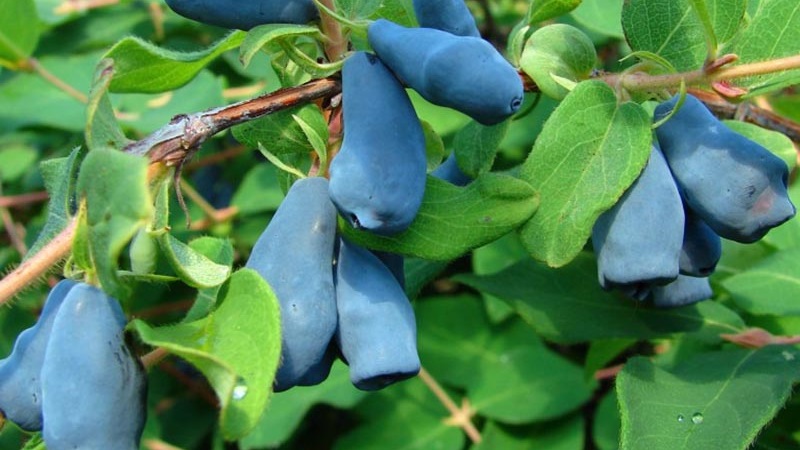
Honeysuckle is famous for its unpretentiousness and ability to grow in any climate. The crop prefers areas with loose, well-drained, nutritious soil. The optimal type for garden and edible honeysuckle is loam, fertilized with organic matter.
The plant grows poorly in swampy areas with heavy, clogged soil, devoid of moisture. For planting, select places with a low occurrence of groundwater. Excess moisture leads to decay of the root system. Experienced gardeners recommend planting bushes not only on loam, but also on sandy loam soil and black soil. This type of soil contributes to the growth and development of honeysuckle, increasing its productivity.
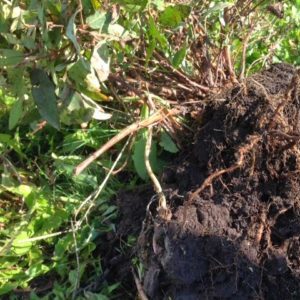
The loam is loose, air permeable, which contributes to the saturation of the root system with oxygen and moisture. Such soil consists of 70% turf and 30% of coarse sand.
Sandy loam consists of silt and sand, quickly passes moisture, warms up after the snow melts and is considered an excellent alternative to loam. Chernozem contains organic matter and minerals that contribute to the growth and development of bushes. Every year, plant residues remain in the soil, saturating it with humus, phosphorus and calcium. Sandy soil dries quickly, nutrients are washed out of it, and water-soluble fertilizers seep into the lower layer, so it is not suitable for the cultivation of honeysuckle.
Gardeners of Siberia, the North-West region and the Far East do not pay attention to the composition of the soil when planting honeysuckle, and residents of the southern regions complain about poor crop growth on black soil. This is due to the peculiarities of the honeysuckle root system.
The plant has a taproot, but short - only 0.5 m, and there are many lateral roots. During dry periods, the hard, cracked earth literally tears apart the thin branches. During the rainy season or active irrigation, chernozem turns into a sticky, airtight mass. The solution to the problem is to improve the soil structure annually.
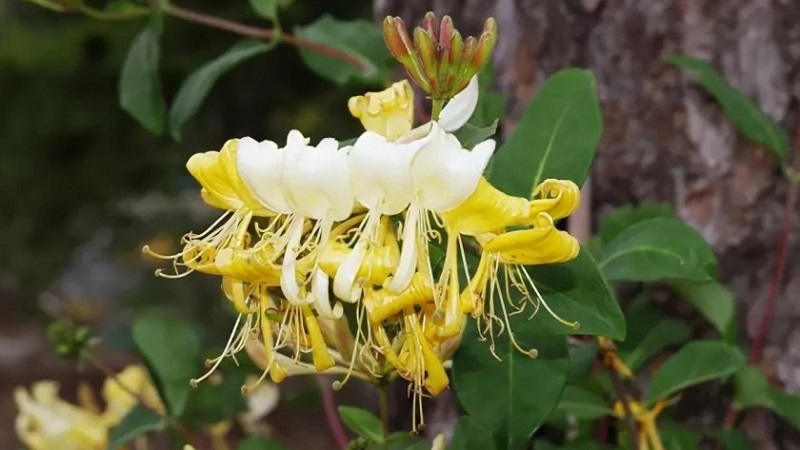
Optimal pH
Let's figure out what kind of soil honeysuckle loves - acidic or alkaline.
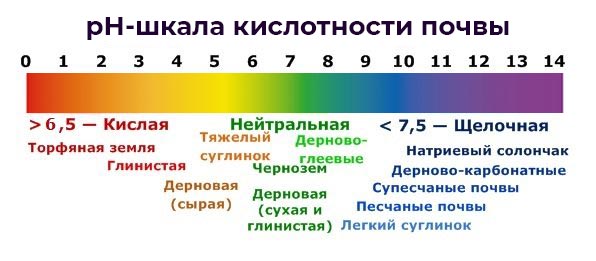
Soil acidity is not the least important when growing a crop. She prefers soil with a neutral pH, does not like acidic and alkaline soil. The fruiting and appearance of the bush depends on the level of acidity.
The pH is measured on a scale from 1 to 14. The acidity of the soil is checked using litmus papers. These can be purchased at gardening stores. Before planting, they collect the soil in different parts of the site, place it in cloth bags and immerse it in clean water for 5 minutes. The test strip is lowered there and the result is evaluated after 10 seconds.
An indicator in the range from 5 to 7 indicates neutral acidity, from 1 to 5 - for acidic, above 7 - for an alkaline reaction. The soil is brought to normal six months before planting the culture. To do this, dolomite flour is added to the ground: 0.5 kg per 1 m² - in acidic soil, 0.4 kg per 1 m² - in slightly acidic soil.
The best soil for honeysuckle
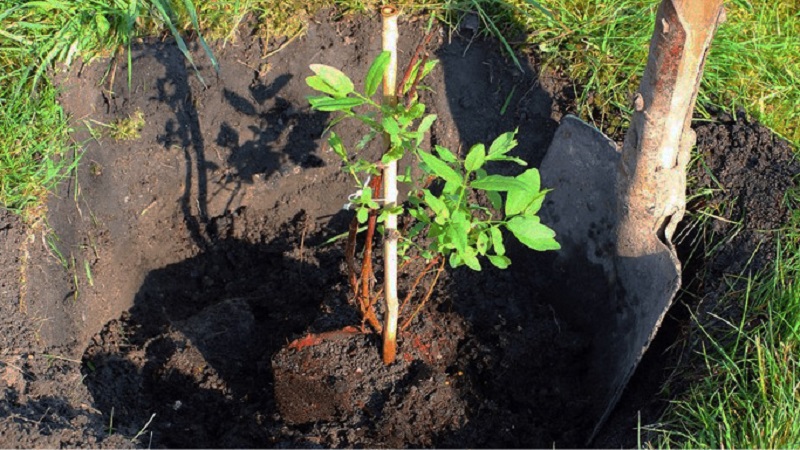
In what land should honeysuckle be planted? The soil for decorative and edible honeysuckle should be structured, moisture and breathable. To determine its composition by eye, dig in the earth with a shovel by at least 10 cm, throw it up and examine the layer:
- if the earth fell as a whole pancake, there is a lot of clay in its composition;
- if the reservoir has completely crumbled, there is a lot of sand in the composition;
- if the top layer is scattered into lumps of different sizes, the structure is excellent.
Humus and peat, turf and river sand are added to the composition of the soil for honeysuckle. In alkaline soil - high-moor peat of a red hue, in acidic - ash or slaked lime.
What kind of soil do cucumbers like. What kind of land do cucumbers like?
The main requirements of the culture for the mechanical composition of the soil are high air permeability and moisture capacity, therefore, cucumbers are recommended to be planted on light and medium loams, which are distinguished by good aeration of the root system, evenly distribute and retain moisture.
For good development, a cucumber needs mineral and organic nutrition, which comes from the soil immediately after planting the plants, so the soil should be high in humus and with an optimal ratio of macronutrients.
Important minerals:
- Nitrogen. With its lack, the growth of the aboveground part, the development of roots, slows down.
- Potassium. Deficiency of the mineral weakens plants, reduces resistance to disease and cold.
- Phosphorus. With a shortage, plant growth and fruit formation slows down.
- Magnesium. Leaves turn yellow, become brittle, fall off. Plant growth and fruit development slows down.
The culture is demanding on the reaction of the soil solution and does not tolerate acidification. The optimum acidity level is pH 6.2-6.8.
Cucumbers love warm soil. Planting seedlings and planting seeds is possible only after warming up the soil to t 18 ° C. With a decrease in t to 14-15 ° C for 3-5 days, the roots of the cucumber cease to develop.
This can lead to the death of plants.Surviving cucumbers will be weak and prone to disease. The yield will be greatly reduced.
Cucumbers develop better if the soil is 2-3 ° C warmer than the air. Average daily t of air for a cucumber is 16-32 ° C. These indicators are also used for ground control.
Soil moisture should be 75-85%. In the future, to control the moisture content of the soil, a handful of earth is taken from the root layer and squeezed tightly in a fist. If water comes out, the humidity level is over 80%. If the lump retains fingerprints, the humidity is over 70%. The lump crumbles - less than 60%. 